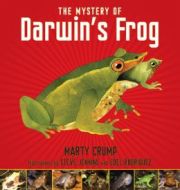Pick of the Day: The Mystery of Darwin's Frog

![]() CRUMP, Marty. The Mystery of Darwin’s Frog. illus. by Steve Jenkins. 40p. bibliog. chron. further reading. glossary. index. maps. photos. websites. Boyds Mills. 2013. RTE $16.95. ISBN 978-1-59078-864-6. Gr 5-7–Most frog species give parenting the go-bye after egg-laying and fertilization, but a select number of these amphibious hoppers take their nurturing skills seriously. One of these “caring” species is Rhinoderma darwinii, an inch-long frog discovered by Charles Darwin in Chile in 1834, while on his expedition aboard the Beagle. Other scientists investigated little Rhinoderma from time to time over the years, discovering that the males slurp up their almost-hatched or newly hatched tadpoles, brood them in their vocal sacs, and perhaps even feed them with substances released by the lining of the sac. Crump entered the Rhinoderma arena of investigation after years of work on other South American frog species, and in clear, readable prose she describes the earlier investigations of this intriguing frog and records her own efforts to document how it lives in the wild. She discusses her findings and goes on to present the problems facing not only Darwin’s frogs, but also frogs in general–loss of habitat, pollution, and the assault of the lethal Bd fungus. The book is aglow with clear color photos and some great artwork. Team this with Laurence Pringle’s fine Frogs! Strange and Wonderful (Boyds Mills, 2012), Nic Bishop’s colorful Frogs (Scholastic, 2008), and Mark W. Moffett’s eye-catching Face to Face with Frogs (National Geographic, 2008) for a fascinating unit, or, for more advanced frog lovers, with Sandra Markle’s sterling The Case of the Vanishing Golden Frogs (Millbrook, 2012) and Pamela Turner’s superb The Frog Scientist (Houghton, 2009). Eye-catching and thought-provoking.–Patricia Manning, formerly at Eastchester Public Library, NY
CRUMP, Marty. The Mystery of Darwin’s Frog. illus. by Steve Jenkins. 40p. bibliog. chron. further reading. glossary. index. maps. photos. websites. Boyds Mills. 2013. RTE $16.95. ISBN 978-1-59078-864-6. Gr 5-7–Most frog species give parenting the go-bye after egg-laying and fertilization, but a select number of these amphibious hoppers take their nurturing skills seriously. One of these “caring” species is Rhinoderma darwinii, an inch-long frog discovered by Charles Darwin in Chile in 1834, while on his expedition aboard the Beagle. Other scientists investigated little Rhinoderma from time to time over the years, discovering that the males slurp up their almost-hatched or newly hatched tadpoles, brood them in their vocal sacs, and perhaps even feed them with substances released by the lining of the sac. Crump entered the Rhinoderma arena of investigation after years of work on other South American frog species, and in clear, readable prose she describes the earlier investigations of this intriguing frog and records her own efforts to document how it lives in the wild. She discusses her findings and goes on to present the problems facing not only Darwin’s frogs, but also frogs in general–loss of habitat, pollution, and the assault of the lethal Bd fungus. The book is aglow with clear color photos and some great artwork. Team this with Laurence Pringle’s fine Frogs! Strange and Wonderful (Boyds Mills, 2012), Nic Bishop’s colorful Frogs (Scholastic, 2008), and Mark W. Moffett’s eye-catching Face to Face with Frogs (National Geographic, 2008) for a fascinating unit, or, for more advanced frog lovers, with Sandra Markle’s sterling The Case of the Vanishing Golden Frogs (Millbrook, 2012) and Pamela Turner’s superb The Frog Scientist (Houghton, 2009). Eye-catching and thought-provoking.–Patricia Manning, formerly at Eastchester Public Library, NY
RELATED
The job outlook in 2030: Librarians will be in demand
The job outlook in 2030: Librarians will be in demand
ALREADY A SUBSCRIBER? LOG IN
We are currently offering this content for free. Sign up now to activate your personal profile, where you can save articles for future viewing






Add Comment :-
Be the first reader to comment.
Comment Policy:
Comment should not be empty !!!